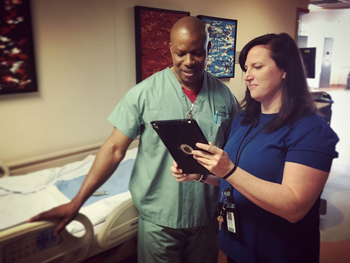Staff safety is patient safety: St. Michael’s commitment to prevent staff injury

By Emily Holton

Melissa Brown-Grassby interviews a clinical assistant in the Trauma-Neurosurgery unit.
St. Michael’s is examining staff safety through a new lens: quality improvement. For the first time, preventing staff injury is among the hospital’s top priorities for improving quality of care, and is listed in its annual Quality Improvement Plan.
“The hospital has dozens of important quality improvement projects underway at any given time,” said Anne Trafford, Vice-President Quality, Performance, Information Management and Chief Information Officer. “However when we single out an issue to be part of our Quality Improvement Plan, it becomes a corporate priority. This is where discussions about staff safety belong: at all-staff meetings, in the CEO’s office and at the Board of Directors’ table. Just like patient safety, our staff’s safety should be top of mind for everyone.”
Lifting and repositioning patients, although part of the job for many St. Michael’s staff, pose a significant risk of staff injury. Across North America, strains and sprains are among the most common reasons why health care workers lose time at work.
Body mechanics basics:
|
According to Melissa Brown-Grassby, an ergonomist in Corporate Health and Safety Services, many of these injuries are preventable. She is working with the hospital’s Quality and Performance team to perform root-cause analyses and better understand the barriers to injury prevention.
“For example, clinical assistants do a lot of lifting and repositioning patients, but there isn’t a consistent, corporate education strategy to make sure they all know how to do it safely,” said Brown-Grassby. “Developing that program is our first priority. We’re piloting a new curriculum in high-risk areas, and it will soon be offered to every clinical assistant as part of their onboarding.”
Because some clinical assistants are doing several lifts and repositions every shift, even relatively small changes to their technique could prevent big problems over the long run. The education curriculum includes ergonomic strategies for safe lifting, as well as how and when to use patient lifts and slings.
National Injury Prevention Day, a day to raise awareness about the devastating effects of predictable and preventable injuries, is July 5, 2017.
About St. Michael’s Hospital
St. Michael’s Hospital provides compassionate care to all who enter its doors. The hospital also provides outstanding medical education to future health care professionals in more than 29 academic disciplines. Critical care and trauma, heart disease, neurosurgery, diabetes, cancer care, and care of the homeless are among the Hospital’s recognized areas of expertise. Through the Keenan Research Centre and the Li Ka Shing International Healthcare Education Centre, which make up the Li Ka Shing Knowledge Institute, research and education at St. Michael’s Hospital are recognized and make an impact around the world. Founded in 1892, the hospital is fully affiliated with the University of Toronto.
